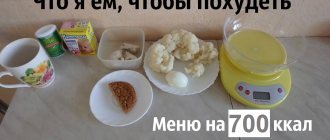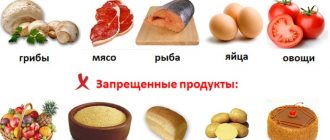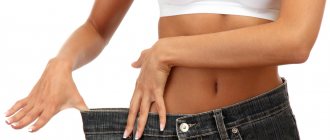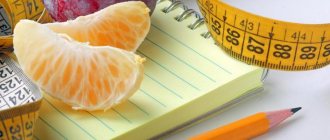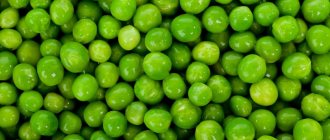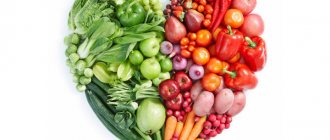Extra pounds cause health problems. To combat excess body weight, people use various methods, including dietary nutrition. For quick weight loss, a diet of 500 calories per day is suitable, but before starting activities, you need to familiarize yourself with the contraindications so as not to worsen your health.
Basic principles
Eating 500 calories per day is a simple method for losing weight. Its principle lies in a daily diet, products for which are selected according to the presence of calories in them. In this case, nutrition can be complete and not based on unloved foods. When compiling a menu, the energy value of each dish is calculated. According to WHO standards, the minimum daily calorie intake is 1200 units. When this value decreases, the human body experiences stress, so it is forbidden to follow a diet for 2 days in a row.
For people who have chosen a diet of 500 calories per day, the following nutritional plan is suitable:
- On Mondays you can eat all the dishes you want.
- Tuesday is a fasting day.
- On Wednesday a person again eats whatever he wants.
- On Thursday it is necessary to arrange a fasting day.
- On Fridays, Saturdays and Sundays there are no calorie restrictions.

For mono-fasting days, you can use products such as kefir, fermented baked milk, yogurt, boiled chicken breast, boiled vegetables, fresh cucumbers and tomatoes. If you follow the diet plan, you can lose 5–7 kg in 14 days. If a person has health problems, then on fasting days the amount of calories consumed is increased. To minimize harm to the body, you need to add a certain amount of calories to 500, which is individual for each person.
Algorithm of actions:
- To determine energy value, you will need to subtract 100 units from a person’s height. If the indicator is less than the person’s weight, then the first condition applies. When the indicator is greater than or equal to body weight, the second condition applies.
- In the future, weight must be subtracted from height units. Under the first condition, the result is multiplied by 3, and under the second, by 2.
For example, a person is 154 cm tall and weighs 66 kg. First, subtract 100 from 154 to get 54. Since 54 is less than 66, the first condition is met. Subtract 66 from 154 and get 88. To find out the additional calories, 88 is multiplied by 3. A person will have to add another 264 calories to 500 kcal.
https://youtu.be/LYivH_2POLc
500 Calorie Diet for Weight Loss: Foods to Avoid
- Processed foods such as sausages and salami.
- Canned vegetables, fruits, etc.
- Energy drinks, carbonated drinks and bottled fruit juices.
- Dried fruits.
- Sweet foods such as cake, pastries, pancakes and candies.
Conclusion
The 500 calorie diet for weight loss is not for everyone. You should follow it only under the supervision of a doctor and nutritionist. While following a VLCD may help reduce weight temporarily (if followed for a short time), it may lead to health risks in the long term. Hence, practice portion control and maintain a healthy lifestyle to lose weight gradually.
Contraindications and dangers of diet
Fasting days benefit every person, but not with 2 or more days of 500 kcal per day. To avoid becoming a victim of negative consequences, you need to know about the contraindications of the diet. It is not used if:
- reduced immune defense;
- stomach diseases in acute or chronic form;
- special dietary nutrition for the treatment of various pathologies.
When carrying a child and breastfeeding, it is not recommended to limit yourself to a 500-calorie diet. When cutting calories, a person may encounter side effects, which in most cases do not occur immediately. These include:
- nausea;
- vomiting;
- loss of appetite;
- weakening of the body's protective function;
- increased sensitivity to infectious diseases;
- development of gastrointestinal diseases.
These phenomena cannot be ignored, as they are dangerous to health, therefore, if a negative reaction of the body occurs, it is necessary to abandon the diet.
List of permitted and prohibited products
During the diet, a person must avoid certain foods, including:
- salt (to improve the taste of the dish, you can add soy sauce to it, but in small quantities);
- dried fruits;
- coffee;
- tea (green tea with ginger and without sugar is allowed);
- fatty and fried foods;
- cereals and vegetables containing starch (rice, semolina and corn cereals, potatoes and beets);
- milk and dairy products;
- fruits other than grapefruit and pineapple;
- smoked and flour products;
- products containing high levels of sugar (those with a sweet tooth are allowed to use a sweetener).

The list of allowed foods on a 500 calorie diet is not too long. A person who decides to use this method for losing weight can eat:
- grapefruit or pineapple;
- fresh vegetables without starch;
- boiled chicken meat without skin;
- egg whites;
- ginger tea;
- kefir;
- low-fat yoghurt and fermented baked milk;
- vegetable and meat broths.
Expert answers to readers' questions
How many pounds will I lose if I eat 500 calories a day?
Following a VLCD (500 calories per day) can help you lose 15-20 pounds per month.
How much weight can you lose per week on the 5:2 diet?
The 5:2 diet plan can help you lose 5-7 pounds per week, depending on your body type.
What recipes can I include in a 500 calorie diet?
Foods that are loaded with low-calorie vegetables and fruits can be included in a 500-calorie diet. You can prepare vegetable soup, vegetable salad, fruit salad with low-fat yogurt, or a serving of fried chicken or fish with grilled vegetables for lunch or dinner to satisfy your hunger pangs.
Is it possible to stick to a 500 calorie diet for 3-4 weeks?
Following a very low calorie diet (500 calories) for more than a week makes your body weak and reduces your immunity and performance. Hence, it is important to consult your doctor and nutritionist before following VLCD for a long time.
Self-calculation of calorie content of foods
You can independently calculate the calorie content of a dish using the calorie table, which indicates the energy value of each product. To avoid making mistakes in your calculations, you can use an online calorie calculator or use other methods. There are many programs for the computer, as well as applications for smartphones and tablets. They display the calorie content of an individual product and a dish consisting of several ingredients.

Sample menu for the week
A 7-day menu, including breakfast, snack, lunch, afternoon snack and dinner, might look like this. Monday:
- For breakfast: oatmeal boiled in water (100 g), apricots (2 pieces) and green tea without sugar.
- During a snack: tomato juice (100 g).
- For lunch: onion soup (200 g), boiled quail meat (100 g).
- During the afternoon snack: natural yoghurt 2% (100 g).
- For dinner: cottage cheese (100 g), strawberries (50 g).
Tuesday:
- For breakfast: barley porridge boiled in water (100 g), black currants (500 g), latte coffee (100 g).
- During a snack: carrot salad (100 g) and orange (1 piece).
- For lunch: grilled dorado (100 g), spinach (50 g), tomato (2 pcs), green tea.
- During the afternoon snack: blackberries (50 g).
- For dinner: kefir 1% (200 g), orange (2 pcs).
Wednesday:
- For breakfast: buckwheat boiled in water (100 g), parsley (50 g), apple juice (100 g).
- During snack: milk 1% (100 g).
- For lunch: boiled pollock fish (100 g), cucumber (2 pieces), carrot juice (100 g).
- During the afternoon snack: fermented baked milk (100 g).
- For dinner: cottage cheese (100 g), blueberries (50 g), green tea.
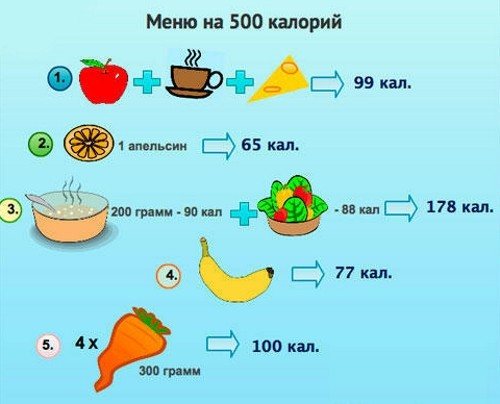
Thursday:
- For breakfast: omelette (100 g), pumpkin juice (100 g).
- During a snack: orange (1 piece).
- For lunch: beetroot soup (150 g), lemonade (100 g).
- During the afternoon snack: natural yoghurt 2% (100 g).
- For dinner: mushroom soup (200 g).
Friday:
- For breakfast: rice porridge with water (100 g), peach juice (100 g).
- During a snack: natural yoghurt 2% (100 g).
- For lunch: boiled turkey fillet (100 g), lettuce (100 g), sweet red pepper (100 g).
- During the afternoon snack: grapefruit juice (100 g).
- For dinner: cottage cheese (150 g), blueberries (50 g).
Saturday:
- For breakfast: oatmeal with milk (100 g), latte coffee (100 g).
- During snack: carrot juice (100 g).
- For lunch: celery soup (150 g), crab meat (100 g), cucumber (1 piece), tomato (1 piece), lemonade (100 g).
- During the afternoon snack: kefir 1% (100 g).
- For dinner: steamed chicken breast (100 g), tomato (2 pcs).
Sunday:
- For breakfast: barley porridge boiled in water (100 g), plum juice (100 g).
- During a snack: tomato (2 pcs.).
- For lunch: rassolnik (150 g), parsley (50 g), green tea.
- During the afternoon snack: blackcurrant juice (100 g).
- For dinner: steamed rabbit meat (100 g), arugula (50 g), tomato (1 piece), cucumber (1 piece), dried apricot jelly (150 g).
1500 Kcal day. What your breakfast, lunch and dinner might look like
The 1500 Kcal per day diet remains relevant. Still would! Eat within normal limits, allow yourself sweets, don’t go hungry, and your body weight gradually decreases. On top of everything else, you develop your mathematical abilities. But there’s not always enough time for the latter. We counted the calories for you! We offer three options for breakfast, lunch and dinner, each of which will be approximately 500 Kcal. All with clear examples!
OPTION #1
Breakfast
Hearty pie + tea or coffee
If you have a sweet tooth, then a healthy and satisfying dessert for breakfast, and even with tea or coffee, is what you need. 500 Kcal is, for example, 1 serving of our “Apple Pie without Flour, Butter and Eggs.” Apples, honey, nuts and even dates - there is enough here to recharge your body with vitamins, microelements and dietary fiber in the morning. If you prepare this in the evening, then in the morning you will have a delicious and healthy breakfast waiting for you. What about calories? All four servings amount to 2,043 kcal. But look how rich the composition is:
- Apple: 3 pcs., 219 Kcal;
- Walnuts: 200 g, 1308 Kcal;
- Dates: 20 pcs., 460 Kcal;
- Honey: 1 tbsp. l., 56 Kcal.
We counted everything together and divided it by four (the pie is for four). As a result, we got just 510 Kcal, well, in the morning you can afford a little excess.
Dinner
Chicken fillet + plate of rice + cheese + bread
Sweets are, of course, good, but we completely forgot about protein. We're cooking chicken for lunch. Let's take a recipe for tender and juicy chicken in ginger and kefir. The calorie content of the entire dish for three servings is approximately 700 Kcal. So, if you work a lot, take two servings at once, you will get 466 Kcal. And if you like variety, then consider this option - exactly 500 Kcal:
- 1 serving of chicken in ginger and kefir: 233 Kcal;
- A plate of white cooked rice: 150 g, 174 Kcal;
- Three pieces of Dutch cheese: 15 g, 53 Kcal;
- One rye bread: 13 g, 40 Kcal.
Dinner
Cauliflower casserole + glass of kefir
Let's celebrate the end of the day with vegetables. For example, you can bake cauliflower in eggs and cheese. If you like contrasting dishes, add some broccoli. A glass of kefir before bedtime will also not be superfluous.
- Cauliflower: 180 g, 54 Kcal;
- Chicken egg: 2 pcs., 172 Kcal;
- Dutch cheese: 35 g, 124 kcal;
- Kefir 2%: 250 ml, 127 Kcal.
The calorie content of the evening meal will be 470–480 Kcal.
OPTION #2
Breakfast
2 eggs + light salad + healthy dessert
Can't imagine your breakfast without eggs? Then hard-boil them and combine them with a salad, and for sweets – a healthy dessert. All together contains approximately 450-460 calories.
- Eggs: 2 pcs., 172 Kcal;
- Tomato: 2 pcs., 38 Kcal;
- Cucumber: 3 pcs., 45 Kcal;
- Olive oil: 1 tsp, 40 Kcal;
- 2 servings of “Baked nectarine with wild berries and nuts”: 154 Kcal.
Dinner
Beef dish + vegetables + cashews
We try to recharge so that lunch brings a feeling of fullness, but not so full that after which you want to sleep. We take the recipe for “The most tender beef in a fragrant thick onion-mustard sauce” and combine it with vegetables, we can also take some nuts for a snack. This lunch will cost 497 Kcal:
- Beef in thick sauce: 1 serving, 245 Kcal;
- Vegetable mixture: 220 g, ~ 100 Kcal;
- Roasted cashews: half a handful, 150 Kcal.
Dinner
Model's salad + avocado bread
When you have no idea what else to cook for dinner that is healthy and low in calories, be inspired by the advice of stars and models. For them, diet is already a lifestyle. Let's take model and healthy eating advocate Agyness Deyn's favorite dinner. This is a turkey breast salad: 1 turkey breast, a little arugula, 2 pcs. celery, leeks, a couple of sprigs of dill and parsley, juice of half a lemon and olive oil for dressing. This dinner costs 200 calories, or even less. If you eat not late, and there are still many hours before bedtime, then dinner can be varied. For an active evening, add some bread to your salad with some avocado and cream cheese.
- Agyness Deyn salad: 200 Kcal;
- One loaf of bread: 13 g, 40 Kcal;
- Avocado without pit: 100 g, 160 Kcal;
- Curd cheese: 1 tbsp. l., ~ 31 Kcal.
The calorie content of such a dinner will be approximately 431 Kcal; if desired, both our improvised sandwich and salad can be transformed to the required amount of calories.
OPTION #3
Breakfast
Oatmeal + banana smoothie
We start this morning with one of the most nutritious cereals in the world. With its burst of vitamins, minerals and plant-based antioxidants, oatmeal is a great way to start your day. In addition, it will really make you feel full, which is scientifically proven. We add sweetness to the porridge with honey and berries, and our breakfast is complemented by a glass of yogurt smoothie, which you can drink right away or take to work as a morning snack.
- Drinking yoghurt: 200 g, 104 kcal;
- Oatmeal with water: 150 g, 132 Kcal;
- Honey: 1 tbsp. l., 56 Kcal;
- A handful of blueberries: 30 grams, 14 kcal;
- 1 ½ medium bananas: 150 kcal.
Calorie content of the entire breakfast: 456 Kcal.
Dinner
Salmon + lentils with vegetables
Let's brighten up the gray days with a bright dish! Tender fish awaits you, plus a side dish that will delight the eye with contrasting shades and satisfy gastronomic preferences with a pleasant taste. Even if there is no sun outside, it will be on your plate. The dish is designed for two servings, which is approximately 1050 Kcal.
- Carrots: 1 pc., 24 Kcal;
- Salmon: 400 g, 560 Kcal;
- Boiled lentils: 300 g, 336 Kcal;
- Lemon: 0.5 pcs., 11 Kcal;
- Garlic: 6 Kcal;
- Tomato: 2 pcs., 38 Kcal;
- Onions: 1 pc., 35 Kcal;
- Sweet red pepper: 1 pc., 40 Kcal.
Take one serving of the dish with you for lunch - that's 525 Kcal!
Dinner
Chicken cutlets + buckwheat
If you have completely switched to diet food, then cooking separately for your family is a real challenge. It’s good that there are universal dishes that will please every family member. For example, “The most tender chicken cutlets.” To add less oil, bake the cutlets in the oven. For a side dish, you can cook some buckwheat in water.
- 2 servings of cutlets: 355 Kcal;
- A plate of buckwheat on water: 140 g, 129 Kcal.
A light but at the same time versatile dinner will cost 484 Kcal.
Bon appetit!
Quitting the diet
A low-calorie diet leads to a slower metabolic process to maintain normal vitality. For this reason, when leaving the diet, it is not recommended to sharply increase the caloric content of food, since all excess will turn into fat.
In the first week, you need to add 10% of calories - 50-60 calories, but not more than 100 kcal per week. During the diet, a person can completely get rid of excess weight, so the caloric intake is gradually increased to the level that suits him. Calorie content is calculated using a special formula taking into account height, weight, age and activity.

After following a diet, it is necessary to count proteins, carbohydrates and fats, the proportion of which should be 30:40:30 of the total calories. You should not lower your fat level below 30, as this process contributes to the development of hormonal disorders. If the fat requirement is not met by eating foods, then you can drink 1 tbsp. l. olive oil, including it in your daily calorie intake.
500 calorie diet for weight loss: harmful to health
Lack of nutrition
Following a 500 calorie diet for a long time leads to nutritional deficiencies. A study published in Nutrition Journal found that a very low-calorie diet formula can lead to micronutrient deficiencies.
Significant decreases in serum concentrations of vitamin D, vitamin C, and zinc were observed in obese individuals on a low-calorie diet for more than 12 weeks.
Loss of muscle mass
Do you want to lose weight? After this, lose fat, not muscle. If you are on a VLCD for an extended period, you will begin to lose muscle mass instead of fat mass.
A very low-calorie, low-carb, low-protein diet can lead to skeletal muscle loss. It can give you a "thin-thick" look and make your skin look loose and saggy.
Metabolic changes
Following a very low-calorie diet for a long period slows down your metabolism. This ultimately leads to weight gain when you return to your original eating pattern.
A study published in the journal Nutrition & Metabolism found that sudden weight loss due to a low-calorie diet reduces resting metabolic rate (RMR), but this was not as expected.
500 Calorie Diet for Weight Loss: Reduced Bone Mass
Weight loss due to following a calorie-restricted diet over a long period of time reduces bone mineral density and weakens bone strength.
The study found that low-calorie diet-induced weight loss was accompanied by bone loss. Another study of 48 adults found that caloric restriction (CR) reduced bone mineral density and bone mass.
Development of Gallstones
Following a very low-calorie diet (500 calories) may increase the risk of developing gallstones.
A study published in the International Journal of Obesity found that following a VLCD for more than one year resulted in cholelithiasis (formation of gallstones). Many adults have had to undergo cholecystectomy (removal of the gallbladder).
Healthy Fat Deficiency
A low-calorie diet is devoid of healthy fats to limit unnecessary calorie intake. Eating healthy fats in controlled portions keeps you full and helps you stay healthy.
Following a very low-calorie diet with limited intake of healthy fats reduces the absorption of fat-soluble vitamins, leading to deficiency.
You may be wondering who can follow this diet and who should avoid it. Find the answers below.
Helpful tips for those on a diet
Mono-fasting days should be carried out with a break. Dietary restrictions should not last 2 days in a row. 500 kcal per day is consumed 2 times a week, while following a number of recommendations:
You must drink at least 2 liters of water per day
- when following a dietary diet, it is necessary to take vitamin complexes that replenish the lack of vitamins and minerals in the body;
- to reduce feelings of extreme hunger, eat a small amount of any nuts;
- allowed fruits are used as snacks;
- to get rid of the desire to eat something, drink a glass of chilled water;
- a person should drink at least 2 liters of water per day;
- For motivation, you need to write down the readings on the scales and information about the foods you eat in your diary every day.
The diet must be followed correctly, without introducing additional restrictions that can lead to health problems.
Reviews about the 500 calorie per day diet
Angelina, 33 years old, Krasnodar: “I used the diet when my weight approached 70 kg with a height of 157 cm. In the first days it was hard to control my hunger, but a glass of water helped. The result can be seen within a week, and after 2 weeks the body got used to the regime, but vacation time came and the 4 kg that had gone away during the diet successfully returned. Now I’m trying to get back into shape again, but without breakdowns, following the rules of the diet. Already 2 kg minus.”
Margarita, 46 years old, Moscow: “I switched to 500 kcal a day after divorcing my husband. It was difficult to give up the usual regimen, but the effect of the week-long torment gave me the incentive to continue. In 3 weeks I got rid of 7 kg. Now I’m trying to get out of the diet correctly so that the kilograms don’t come back. A friend advised me to calculate my individual calorie intake, to which I need to gradually increase my weekly caloric intake after the diet. I already eat 850 kcal per day.”
Nina, 25 years old, Saratov: “Before using the diet, you need to make sure that it can be used. I was admitted to the hospital after a week of following a diet with an exacerbation of a stomach ulcer. The pain was terrible. The method brings nothing but health problems. Now I'm looking for other methods of losing weight based on proper nutrition. Especially with such a disease, you have to follow it.”
